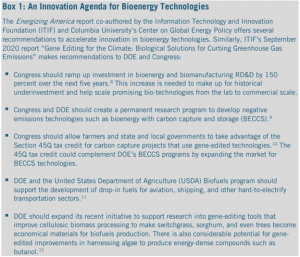TECHNOLOGY GAPS
As part of the U.S. Department of Energy’s (DOE) Office of Energy Efficiency & Renewable Energy (EERE), the Bioenergy Technologies Office (BTO) is one of 10 technology development offices managing a technology portfolio that covers the biomass-to-bioenergy supply chain pictured below.[1]

Source: EERE, March 2016[1]
Key Elements of the FY 2022 Budget Proposal – Federal Energy RD&D: Bioenergy Technologies
The budget proposal seeks $340 million for the Bioenergy program, a 33 percent boost from FY 2021 enacted levels. This includes:
- A 144 percent increase in System Development and Integration - $77.5 million increase in funding to scale up RD&D for biofuel production, focusing on aviation fuels and waste-to-energy technologies
- A 13 percent reduction in Advanced Algal Systems - $5 million reduction in funding for research on direct air capture technologies. In 2020 DOE issued new funding opportunities to integrate DAC with algal bioproduct systems to reduce both algae biomass production costs and net carbon emissions
- A 25 percent increase in Feedstock Technologies – increased funding for national laboratory research and development activities on soil carbon sequestration, bioenergy with carbon sequestration, and other agriculture technologies, continued funding to reduce costs of feedstock logistics, continued funding for the Feedstock-Conversion Interface Consortium (FCIC), continued funding for harvest logistics, quality assurance, biomass densification, and biomass analytic[3]
Because bioenergy plays such an important role in addressing many harder-to-abate transportation and industrial sectors, the suggestion is to ramp-up to 150 percent above FY 2020 levels over the next five years, shown in the box below.[4]

Source: Information Technology & Innovation Foundation, June 2021[5]
The FY 2024 budget request for the Department of Energy includes an increase of 18 percent for clean energy research, development, and demonstration. Highlights of the budget include $3.8 billion for the Office of Energy Efficiency and Renewable Energy. The budget request specifically for Bioenergy technologies is $323 million up from $280 million in FY23. The budget for the DOE’s RD&D totaled $9.3 billion in FY23 including $110 million for bioenergy research.[6]
Updated by Erin Bennett, January 2024

Comments are closed.